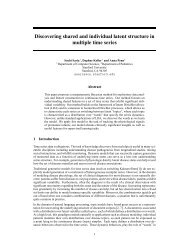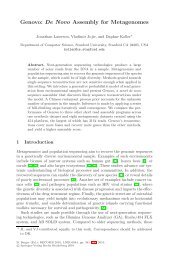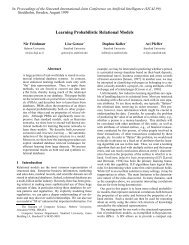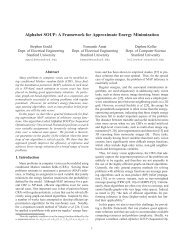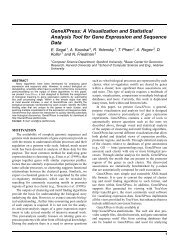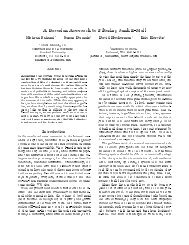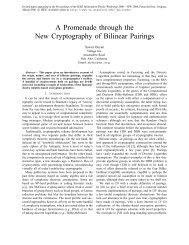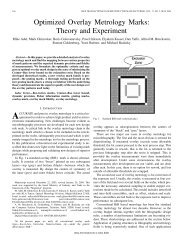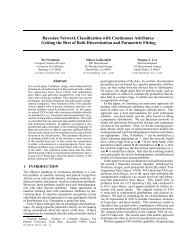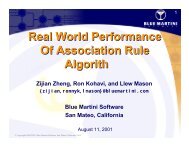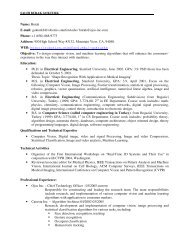Region-based Segmentation and Object Detection - Stanford ...
Region-based Segmentation and Object Detection - Stanford ...
Region-based Segmentation and Object Detection - Stanford ...
You also want an ePaper? Increase the reach of your titles
YUMPU automatically turns print PDFs into web optimized ePapers that Google loves.
3 <strong>Region</strong>-<strong>based</strong> Model for <strong>Object</strong> <strong>Detection</strong><br />
We now present an overview of our joint object detection <strong>and</strong> scene segmentation model. This model<br />
combines scene structure <strong>and</strong> semantics in a coherent energy function.<br />
3.1 Energy Function<br />
Our model builds on the work of Gould et al. [7] which aims to decompose a scene into a number (K)<br />
of semantically consistent regions. In that work, each pixel p in the image I belongs to exactly one<br />
region, identified by its region-correspondence variable Rp ∈ {1,...,K}. The r-th region is then<br />
simply the set of pixels Pr whose region-correspondence variable equals r, i.e., Pr = {p : Rp = r}.<br />
In our notation we will always use p <strong>and</strong> q to denote pixels, r <strong>and</strong> s to denote regions, <strong>and</strong> o to denote<br />
objects. Double indices indicate pairwise terms between adjacent entities (e.g., pq or rs).<br />
<strong>Region</strong>s, while visually coherent, may not encompass entire objects. Indeed, in the work of Gould<br />
et al. [7] foreground objects tended to be over-segmented into multiple regions. We address this deficiency<br />
by allowing an object to be composed of many regions (rather than trying to force dissimilar<br />
regions to merge). The object to which a region belongs is denoted by its object-correspondence<br />
variable Or ∈ {∅,1,...,N}. Some regions, such as background, do not belong to any object<br />
which we denote by Or = ∅. Like regions, the set of pixels that comprise the o-th object is denoted<br />
by Po = <br />
r:Or=o Pr. Currently, we do not allow a single region or object to be composed of<br />
multiple disconnected components.<br />
R<strong>and</strong>om variables are associated with the various entities (pixels, regions <strong>and</strong> objects) in our<br />
model. Each pixel has a local appearance feature vector αp ∈ Rn (see [7]). Each region has an<br />
appearance variable Ar that summarizes the appearance of the region as a whole, a semantic class<br />
label Sr (such as “road” or “foreground object”), <strong>and</strong> an object-correspondence variable Or. Each<br />
object, in turn, has an associated object class label Co (such as “car” or “pedestrian”). The final<br />
component in our model is the horizon which captures global geometry information. We assume<br />
that the image was taken by a camera with horizontal axis parallel to the ground <strong>and</strong> model the<br />
horizon vhz ∈ [0,1] as the normalized row in the image corresponding to its location. We quantize<br />
vhz into the same number of rows as the image.<br />
We combine the variables in our model into a single coherent energy function that captures the<br />
structure <strong>and</strong> semantics of the scene. The energy function includes terms for modeling the location<br />
of the horizon, region label preferences, region boundary quality, object labels, <strong>and</strong> contextual relationships<br />
between objects <strong>and</strong> regions. These terms are described in detail below. The combined<br />
energy function E(R,S,O,C,v hz | I,θ) has the form:<br />
E = ψ hz (v hz ) + <br />
ψ reg<br />
r (Sr,v hz ) + <br />
ψ bdry<br />
ψ obj<br />
r<br />
r,s<br />
rs + <br />
o<br />
o (Co,v hz ) + <br />
o,r<br />
ψ ctxt<br />
or (Co,Sr) (1)<br />
where for notational clarity the subscripts on the factors indicate that they are functions of the pixels<br />
(appearance <strong>and</strong> shape) belonging to the regions, i.e., ψ reg<br />
r is also a function of Pr, etc. It is assumed<br />
that all terms are conditioned on the observed image I <strong>and</strong> model parameters θ. The summation<br />
over context terms includes all ordered pairs of adjacent objects <strong>and</strong> regions, while the summation<br />
over boundary terms is over unordered pairs of regions. An illustration of the variables in the energy<br />
function is shown in Figure 1.<br />
The first three energy terms are adapted from the model of [7]. We briefly review them here:<br />
Horizon term. The ψhz term captures the a priori location of the horizon in the scene <strong>and</strong>, in our<br />
model, is implemented as a log-gaussian ψhz (vhz ) = −log N(v hz ;µ,σ2 ) with parameters µ <strong>and</strong> σ<br />
learned from labeled training images.<br />
Knowing the location of the horizon allows us to compute the world height of an object in the<br />
scene. Using the derivation from Hoiem et al. [12], it can be shown that the height yk of an object<br />
(or region) in the scene can be approximated as yk ≈ h vt−vb where h is the height of the camera<br />
vhz−vb origin above the ground, <strong>and</strong> vt <strong>and</strong> vb are the row of the top-most <strong>and</strong> bottom-most pixels in the<br />
object/region, respectively. In our current work, we assume that all images were taken from the<br />
as a feature in our region <strong>and</strong> object terms.<br />
same height above the ground, allowing us to use vt−vb<br />
v hz −vb<br />
<strong>Region</strong> term. The region term ψ reg in our energy function captures the preference for a region<br />
to be assigned different semantic labels (currently sky, tree, road, grass, water, building, mountain,<br />
foreground). For convenience we include the v hz variable in this term to provide rough geometry<br />
information. If a region is associated with an object, then we constrain the assignment of its class<br />
label to foreground (e.g., a “sky” region cannot be part of a “car” object).<br />
3




